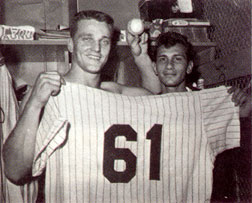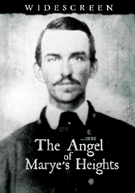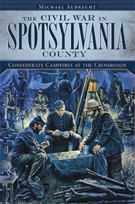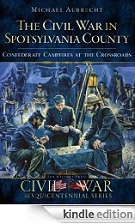 This weekend the New York Yankees organization will commemorate the 50th anniversary of Roger Maris’ historic 1961 homerun season. Even the most ardent Yankees haters (to include my friend and co-author Eric Wittenberg) have to give Roger respect for breaking one of the most difficult and coveted records in all of professional sports. The Maris family will be on hand, as well as surviving members of the 1961 Yankees squad. To commemorate this commemoration, here is an article that I penned for Baseball-Almanac a few years ago titled 61 in ‘61:
This weekend the New York Yankees organization will commemorate the 50th anniversary of Roger Maris’ historic 1961 homerun season. Even the most ardent Yankees haters (to include my friend and co-author Eric Wittenberg) have to give Roger respect for breaking one of the most difficult and coveted records in all of professional sports. The Maris family will be on hand, as well as surviving members of the 1961 Yankees squad. To commemorate this commemoration, here is an article that I penned for Baseball-Almanac a few years ago titled 61 in ‘61:
When modern baseball fans look back at all the classic record-breaking moments that they have witnessed in their lifetime, it is quite possible that one number really stands out in their mind. That number is 62. Why? Because most of them could never forget the excitement and pageantry of watching Mark McGwire and Sammy Sosa [since then exposed as juicers] both set new standards in 1998, by breaking the all-time single season home run record, the most revered record in all of sports.
It was the first time, in a long time, that America’s passion for the game resembled the glory days, when it truly was our nation’s pastime and the players were larger-than-life heroes. And although their legacy has come under scrutiny due to the steroids scandal that has stained the entire era, both players were credited for giving major league baseball a much needed shot in the arm (no pun intended).
Despite the fact that another suspicious slugger named Barry Bonds [also a chemically enhanced fraud] has since set the new magic number at 73, their race seemed more romantic and brought a lot of overdue attention to the man whose record they were chasing, Roger Maris. It also seemed more fitting as they were both competing in a similar situation as Maris and his teammate Mickey Mantle had in 1961. Both contests were between two friends pushing each other to be better on and off the field; neither ever letting their competitiveness get in the way of their friendship or their friendship get in the way of their competitiveness.
The press had dubbed them “The M&M Boys” and their story is an incredible example of what impact sports can have when two teammates who are as opposite as can be, come together to create something special. To understand this, one has to look at both men individually to see what they accomplished together.
Roger Maris was a great ballplayer who never got the respect he deserved. Unfortunately, the press never really considered him “hero” material, but when you look at his life, on and off the field, you realize that he was the ideal hero. He was a good husband, father and athlete, who was more concerned with the success of his team than his own individual stats. (An attitude seldom seen in today’s game.)
No record ever hung around a player’s neck more like an albatross than Roger Maris’ 61 homers in 1961. As late as the 1980 All-Star Game he fumed, “They acted as though I was doing something wrong, poisoning the record books or something.” In surpassing Babe Ruth’s supposedly unsurpassable record, Maris faced the hostility of the baseball public on several fronts.
First, although he had been the 1960 American League MVP, he was basically a .269 hitter, still an unknown quantity unworthy of dethroning America’s greatest sports hero. That he played the game with a ferocious intensity and that he was a brilliant right fielder and an exceptional baserunner, well, that was irrelevant.
Second, for most of the season Maris wasn’t the only batter chasing the ghost of the Babe. His teammate Mickey Mantle, the successor to Ruth, to Lou Gehrig, and to Joe DiMaggio, was the people’s choice. It was Mantle who hit 500-foot home runs that thrilled fans. Mantle garnered support as the season-long chase headed toward September.
Maris? He was merely efficient; a left-handed hitter who had just the swing to take advantage of that friendly porch in Yankee Stadium’s right field. He rarely hit a homer further than 400 feet. His charisma quotient was almost nil. That 1961 season was the first year of expansion and the first year of the 162-game season. With the addition of two teams to the American League, many hitters had their greatest seasons, such as Norm Cash, who somehow hit .361, corked bat and all. Expansion also meant an expanded schedule. Ruth had set his record in 1927 in a 154-game season.
So for many people, Maris’ feat would be tainted if he needed more than 154 games to break Ruth’s record. Commissioner Ford Frick even announced that if Maris took more than 154 games to break the record it would go into the record books as a separate accomplishment from Ruth’s, with an asterisk, so to speak. “As a ballplayer, I would be delighted to do it again,” Maris once remarked. “As an individual, I doubt if I could possibly go through it again. They even asked for my autograph at mass.” As always, Maris was being honest. He once said about playing baseball for a living, “It’s a business. If I could make more money down in the zinc mines, I’d be mining zinc.” Could anyone have been more unlike the Babe?
In his first game in Yankee pinstripes, Maris singled, doubled, and smacked two home runs. His MVP numbers included a league leading 112 RBIs and 39 home runs, only one behind league-leader Mantle, although he missed 18 games with injuries. In 1961 Maris stayed healthy and played 161 games, a career high. As he and Mantle made their charge at Ruth’s home run record, the Yankees even considered switching Maris, who batted third, and Mantle, who batted fourth, to give Mantle a better shot at the record.
If the switch had been made, Maris almost certainly would not have broken the record. Consider this: Maris did not receive one intentional walk in 1961. After all, who would walk Maris to get to Mantle? While most players would have welcomed such a dilemma, Maris did not. “I never wanted all this hoopla,” he said. “All I wanted is to be a good ballplayer, hit 25 or 30 homers, drive in around a hundred runs, hit .280, and help my club win pennants. I just wanted to be one of the guys, an average player having a good season.”
Mantle fell back in the middle of September when he suffered a hip injury. Maris kept it up and went into the 154th game of the season in Baltimore with 58 homers. He gave it his best shot that night. He hit No. 59 and then hit a long foul on his second-to-last at bat. Alas, in his last at bat, against Hoyt Wilhelm, he hit a checked-swing grounder. “Maybe I’m not a great man, but I damn well want to break the record,” he said. He finally did it on the last day of the season against the Red Sox’s Tracy Stallard. Fittingly it went about 340 feet into Yankee Stadium’s right field porch. Maris also made back-to-back MVP honors, driving in a league leading 142 runs.
As expected MLB Commissioner (and The Babe’s ghostwriter), Ford C. Frick ruled that since Maris had played in a 162-game schedule (as opposed to Ruth’s 154), his record would be listed officially with a qualifying asterisk; this decision stood until 1991. Although, he never experienced the same hitting streak, his consistency as a power hitter continued and he hit 275 home runs during his 12-year career.
Maris remained bitter about the experience. He said of that season, “Do you know what I have to show for 61 home runs? Nothing. Exactly nothing.” Despite all the controversy, Maris was awarded the American League’s MVP Award for the second straight year. It is said, however, that the stress of pursuing the record was so great for Maris that his hair occasionally fell out in clumps during the season. Later Maris even surmised that it might have been better all along had he not broken the record or even threatened it at all.
Mickey Mantle, like Maris, was also an exceptional athlete from the Midwest, but with a press-friendly personality and movie-star good looks that made him a fan favorite both on and off the field. “The Mick” fit into the Yankee persona perfectly and his contributions to the pinstripes were on par with the long line of Yankee legends that had come before him. Mickey represented what America is all about: a young kid from the mid-west, going to the big city, living the American dream and becoming a sports legend. A courageous player, he achieved greatness despite an arrested case of osteomyelitis, numerous injuries and frequent surgery.
The powerful Yankee switch-hitter belted 536 homers (many of the tape-measure variety), won the American League home run and slugging titles four times, collected 2,415 hits, and batted .300 or more 10 times. The three-time MVP was named to 20 All-Star teams. He holds numerous World Series records, including most home runs (18).
Opposites yes, but also equals, both summed up their own careers perfectly. Mickey said, “It was all I lived for, to play baseball.” and Roger was quoted as saying, “All I wanted was to be a good ballplayer.”
Maris has not been elected to the National Baseball Hall of Fame, but his teammate Mantle was elected unanimously in his first year of eligibility. Many historians credit Ford Frick’s decision to ‘footnote’ Maris’ epic achievement as having an effect on his ability to be put on the ballot. Others simply state that Maris did not have the cumulative statistics to warrant such an honor. Ironically, the decision to add the asterisk has also stained the commissioner’s legacy.
The first MLB leader not to have a political background, Ford Frick was a multi-talented journalist with experience in teaching, ghost writing and advertising. After graduating from DePauw University, Frick took a position as an English teacher at Colorado High School and also freelanced as a beat writer for the Colorado Springs Gazette. Two years later, he left teaching to become the supervisor of training in the rehabilitation division of the War Department for four states (Colorado, Utah, New Mexico and Wyoming). Although the position was important, Frick could not ignore his “writer’s bug” and briefly worked for the Rocky Mountain News in Denver before returning to Colorado Springs to open his own advertising agency and write a weekly editorial column for the Colorado Springs Telegraph.
An enthusiastic baseball fan, Frick landed his dream job in 1922 after joining the sports staff of the New York American. The following year, he moved on to the Evening Journal where he covered the New York Yankees and eventually became a ghostwriter for Babe Ruth. Things got even better when he finally left the typewriter behind in favor of the microphone to become a sportscaster with station WOR. A rising figure in the sports media, Frick was named the first director of the National League Service Bureau and was put in charge of all publicity for Major League Baseball. He excelled rapidly at the position and was later elected as the President of the National League, succeeding John A. Heydler.
His first act as president was a passionate proposal for the establishment of a National Baseball Museum to honor the greatest players ever to take the field. This, of course, led to the Hall of Fame. He was also instrumental in saving several franchises from bankruptcy, including the Brooklyn Dodgers, Philadelphia Phillies, Boston Braves, Cincinnati Reds and the Pittsburgh Pirates. Immensely popular amongst the owners, he held the position until September 1951 when sixteen of them elected him commissioner on September 20, 1951.
During his tenure, Frick was responsible for many changes in the reconstruction, expansion and transition of baseball. Some of the major changes included the growth from eight to ten teams in each league; the establishment of multiple national television contracts; a league draft and college scholarship system; and the introduction of baseball on the international level in countries such as Japan, Central America, Holland, Italy and Africa.
Not unlike his Major League Baseball forefathers, Frick was contested on several occasions for policies that did not agree with the public’s view. The verdict surrounding Roger Maris’ single-season homerun record remained at the top of that list. The decision stood for the next thirty years and remained as a black eye on an otherwise stellar career. Frick was inducted into the Baseball Hall of Fame in 1970. He also became the namesake of the Ford C. Frick Award, which is given to outstanding Hall of Fame broadcasters.
In 1991, then MLB Commissioner Fay Vincent officially removed the asterisk from the record. Unfortunately, Roger Maris had passed away in 1985, never receiving full credit for his unparalleled athletic accomplishment.
61 HOMERUNS BY ROGER MARISHR | Game | Date / Box | Pitcher | Team | Throws | Where | Inning |
| 1 | 11 | 04-26-1961 | Paul Foytack | Detroit | Right | Away | 5th |
| 2 | 17 | 05-03-1961 | Pedro Ramos | Minnesota | Right | Away | 7th |
| 3 | 20 | 05-06-1961 | Eli Grba | Los Angeles | Right | Away | 5th |
| 4 | 29 | 05-17-1961 | Pete Burnside | Washington | Left | Home | 8th |
| 5 | 30 | 05-19-1961 | Jim Perry | Cleveland | Right | Away | 1st |
| 6 | 31 | 05-20-1961 | Gary Bell | Cleveland | Right | Away | 3rd |
| 7 | 32 | 05-21-1961 | Chuck Estrada | Baltimore | Right | Home | 1st |
| 8 | 35 | 05-24-1961 | Gene Conley | Boston | Right | Home | 4th |
| 9 | 38 | 05-28-1961 | Cal McLish | Chicago | Right | Home | 2nd |
| 10 | 40 | 05-30-1961 | Gene Conley | Boston | Right | Away | 3rd |
| 11 | 40 | 05-30-1961 | Mike Fornieles | Boston | Right | Away | 8th |
| 12 | 41 | 05-31-1961 | Billy Muffett | Boston | Right | Away | 3rd |
| 13 | 43 | 06-02-1961 | Cal McLish | Chicago | Right | Away | 3rd |
| 14 | 44 | 06-03-1961 | Bob Shaw | Chicago | Right | Away | 8th |
| 15 | 45 | 06-04-1961 | Russ Kemmerer | Chicago | Right | Away | 3rd |
| 16 | 48 | 06-06-1961 | Ed Palmquist | Minnesota | Right | Home | 6th |
| 17 | 49 | 06-07-1961 | Pedro Ramos | Minnesota | Right | Home | 3rd |
| 18 | 52 | 06-09-1961 | Ray Herbert | Kansas City | Right | Home | 7th |
| 19 | 55 | 06-11-1961 | Eli Grba | Los Angeles | Right | Home | 3rd |
| 20 | 55 | 06-11-1961 | Johnny James | Los Angeles | Right | Home | 7th |
| 21 | 57 | 06-13-1961 | Jim Perry | Cleveland | Right | Away | 6th |
| 22 | 58 | 06-14-1961 | Gary Bell | Cleveland | Right | Away | 4th |
| 23 | 61 | 06-17-1961 | Don Mossi | Detroit | Left | Away | 4th |
| 24 | 62 | 06-18-1961 | Jerry Casale | Detroit | Right | Away | 8th |
| 25 | 63 | 06-19-1961 | Jim Archer | Kansas City | Left | Away | 9th |
| 26 | 64 | 06-20-1961 | Joe Nuxhall | Kansas City | Left | Away | 1st |
| 27 | 66 | 06-22-1961 | Norm Bass | Kansas City | Right | Away | 2nd |
| 28 | 74 | 07-01-1961 | Dave Sisler | Washington | Right | Home | 9th |
| 29 | 75 | 07-02-1961 | Pete Burnside | Washington | Left | Home | 3rd |
| 30 | 75 | 07-02-1961 | Johnny Klippstein | Washington | Right | Home | 7th |
| 31 | 77 | 07-04-1961 | Frank Lary | Detroit | Right | Home | 8th |
| 32 | 78 | 07-05-1961 | Frank Funk | Cleveland | Right | Home | 7th |
| 33 | 82 | 07-09-1961 | Bill Monbouquette | Boston | Right | Home | 7th |
| 34 | 84 | 07-13-1961 | Early Wynn | Chicago | Right | Away | 1st |
| 35 | 86 | 07-15-1961 | Ray Herbert | Chicago | Right | Away | 3rd |
| 36 | 92 | 07-21-1961 | Bill Monbouquette | Boston | Right | Away | 1st |
| 37 | 95 | 07-25-1961 | Frank Baumann | Chicago | Left | Home | 4th |
| 38 | 95 | 07-25-1961 | Don Larsen | Chicago | Right | Home | 8th |
| 39 | 96 | 07-25-1961 | Russ Kemmerer | Chicago | Right | Home | 4th |
| 40 | 96 | 07-25-1961 | Warren Hacker | Chicago | Right | Home | 6th |
| 41 | 106 | 08-04-1961 | Camilo Pascual | Minnesota | Right | Home | 1st |
| 42 | 114 | 08-11-1961 | Pete Burnside | Washington | Left | Away | 5th |
| 43 | 115 | 08-12-1961 | Dick Donovan | Washington | Right | Away | 4th |
| 44 | 116 | 08-13-1961 | Bennie Daniels | Washington | Right | Away | 4th |
| 45 | 117 | 08-13-1961 | Marty Kutyna | Washington | Right | Away | 1st |
| 46 | 118 | 08-15-1961 | Juan Pizarro | Chicago | Left | Home | 4th |
| 47 | 119 | 08-16-1961 | Billy Pierce | Chicago | Left | Home | 1st |
| 48 | 119 | 08-16-1961 | Billy Pierce | Chicago | Left | Home | 3rd |
| 49 | 124 | 08-20-1961 | Jim Perry | Cleveland | Right | Away | 3rd |
| 50 | 125 | 08-22-1961 | Ken McBride | Los Angeles | Right | Away | 6th |
| 51 | 129 | 08-26-1961 | Jerry Walker | Kansas City | Right | Away | 6th |
| 52 | 135 | 09-02-1961 | Frank Lary | Detroit | Right | Home | 6th |
| 53 | 135 | 09-02-1961 | Hank Aguirre | Detroit | Left | Home | 8th |
| 54 | 140 | 09-06-1961 | Tom Cheney | Washington | Right | Home | 4th |
| 55 | 141 | 09-07-1961 | Dick Stigman | Cleveland | Left | Home | 3rd |
| 56 | 143 | 09-09-1961 | Mudcat Grant | Cleveland | Right | Home | 7th |
| 57 | 151 | 09-16-1961 | Frank Lary | Detroit | Right | Away | 3rd |
| 58 | 152 | 09-17-1961 | Terry Fox | Detroit | Right | Away | 12th |
| 59 | 155 | 09-20-1961 | Milt Pappas | Baltimore | Right | Away | 3rd |
| 60 | 159 | 09-26-1961 | Jack Fisher | Baltimore | Right | Home | 3rd |
| 61 | 163 | 10-01-1961 | Tracy Stallard | Boston | Right | Home | 4th |
Data courtesy of Baseball-Almanac.com
Updated: Thursday, 22 September 2011 8:46 AM EDT
Permalink | Share This Post





